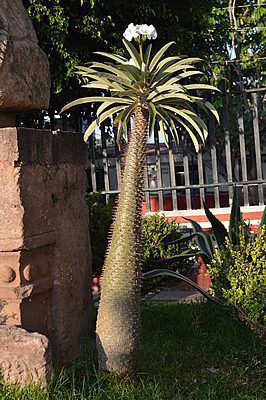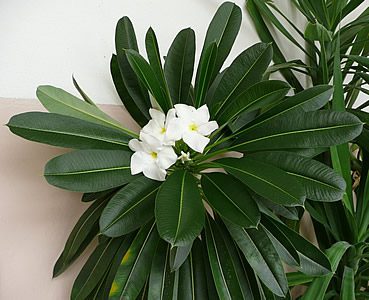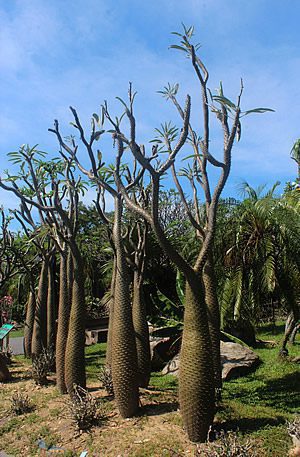Despite its name, the Madagascar palm (Pachypodium lamerei) isn’t truly a palm. It’s a semi-succulent, flowering, and ornamental plant with a shrub to tree-like growth habit, belonging to the same family as desert roses and frangipani. The genus name, ‘Pachypodium‘, comes from the combination of the Greek words ‘pachy‘, meaning ‘thick’, and ‘podium‘, meaning ‘foot’, alluding to the thickened trunks of plants in this genus. As the common name suggests, it’s a native plant of Madagascar Island, off the coast of Africa.

The Madagascar palm typically features a single, thickened trunk from the base, a characteristic trait of the genus known as “paquicaule.” This adaptation allows it to survive through periods of drought by storing water inside. The bark is silver-gray, shiny, and covered with sharp thorns clustered in tubercles. In its natural habitat and when cultivated under favorable conditions, it can reach heights of 8 to 20 feet or more. Typically, its trunk grows columnar until the first flowering, which occurs when it reaches around 5 to 6 feet in height and is about 10 years old, after which it may branch out. There are also different varieties of the species, such as ‘ramosum’, ‘compactum’, ‘cristata’, ‘crested’, and ‘monstruosum’.
Its leaves are simple, dark green, glossy, lanceolate, and with a tomentose underside. They’re about 12 inches long and are spirally arranged at the top of the plant, resembling palm leaves. In spring and early summer, mature plants growing in full sun produce flowers. The inflorescences are terminal, with sturdy and branched peduncles, bearing showy, pentamerous flowers that are white with a yellow center and highly fragrant. When pollinated, it produces banana-like fruits that dehisce, containing numerous winged seeds.
With its sculptural and exotic appearance, the Madagascar palm easily becomes a standout plant in landscaping. It can be incorporated into various styles, ranging from tropical and desert-themed to contemporary designs. Make sure to emphasize the plant’s trunk by giving it enough space and covering the ground with gravel or other non-living coverings. In gardens prone to excess moisture, choose an elevated planting location, using the natural terrain’s slope or creating artificial elevations if needed. Plant the Madagascar palm individually, in spaced groups, or alongside other species like agaves, crotons, cacti, and succulents.

Unfortunately, direct garden cultivation is limited to tropical and semi-arid regions. In colder regions, like the southern part of the country, the plant can be grown in pots, similar to other cacti and succulents, or even as part of your desert rose collection. The key here is to protect the plant during cold weather by bringing it indoors or into greenhouses and positioning it to receive direct sunlight through a window or skylight.
It should be grown in full sun or partial shade, in sandy soil or a suitable cactus and succulent mix. Watering should be sparing, only when the potted plants’ substrate is completely dry. If planting in pots, ensure they have good drainage holes. The Madagascar palm is highly sensitive to overwatering, which can quickly lead to rot, so be cautious not to overwater. Repot annually to refresh the compacted substrate. It doesn’t tolerate intense winter cold (below 12°C or 54°F) or frost. Therefore, in temperate or subtropical climates, it should be placed in well-lit interiors during winter. In winter, many plants lose their leaves and enter dormancy, resuming growth in spring. It’s a fairly pest and disease-resistant species; however, plants grown indoors for extended periods might become susceptible to aphids. It can be propagated from seeds or by rooting young branches that emerge at the top of the plant in spring.


